We’ve all heard about the I-5 Rose Quarter project, the State of Oregon’s plan to widen I-5 and redevelop the lower Albina neighborhood decimated by construction of the freeway. But there’s another neighborhood less than a mile north that also suffered greatly by construction of an interstate.
Today the US Department of Transportation awarded the Portland Bureau of Transportation a $1 million grant to study the reconfiguration of an I-405 offramp.
The North Kerby Avenue offramp tore out dozens of homes in the 1970s between N Mississippi and Vancouver avenues and today it funnels freeway traffic into a dense residential neighborhood. Inspired by the Albina Vision Trust and their effort to rebuild the Albina neighborhood near the Moda Center, Boise-Eliot Neighborhood Land Use and Transportation Committee Chair Allan Rudwick began researching the offramp and its impacts. With the backing of the neighborhood and in partnership with the Portland Bureau of Transportation he championed a grant through the USDOT’s Reconnecting Communities Pilot Program.
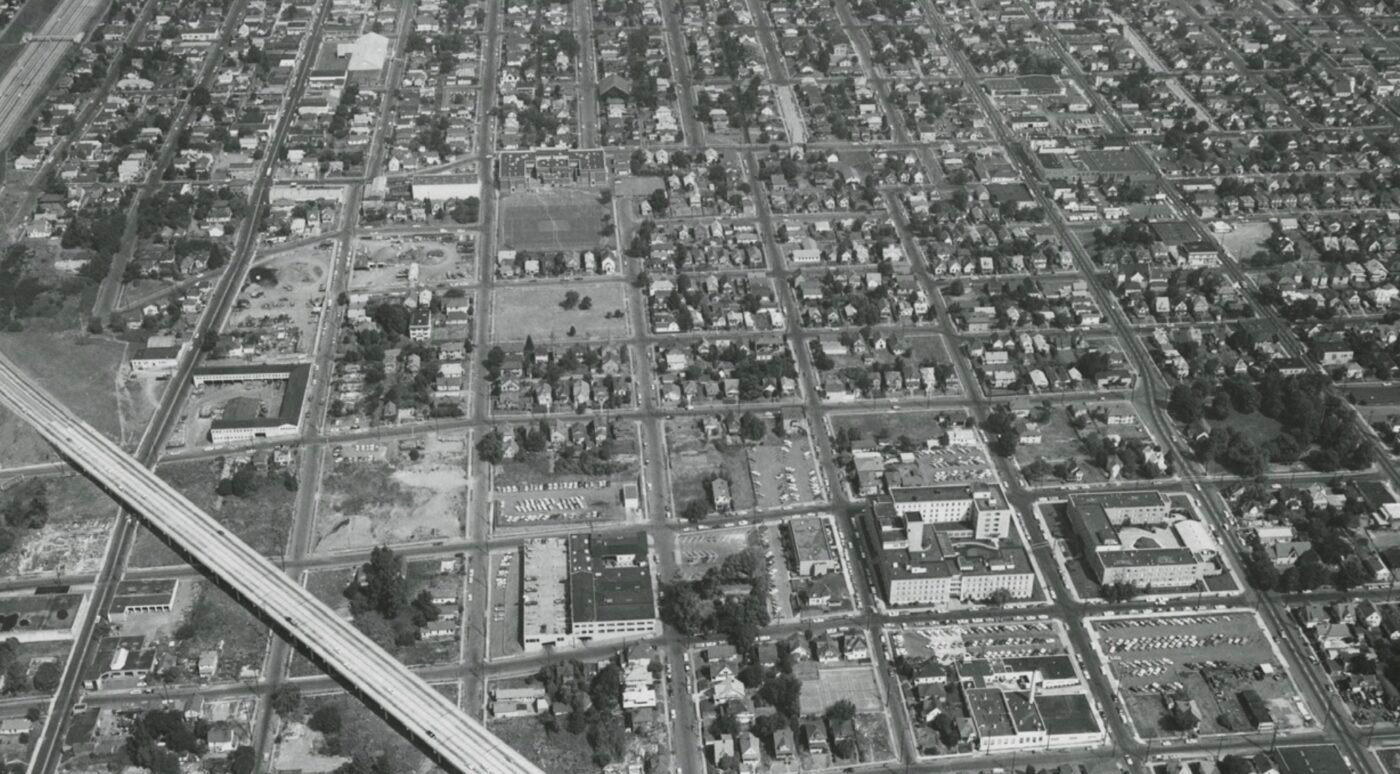
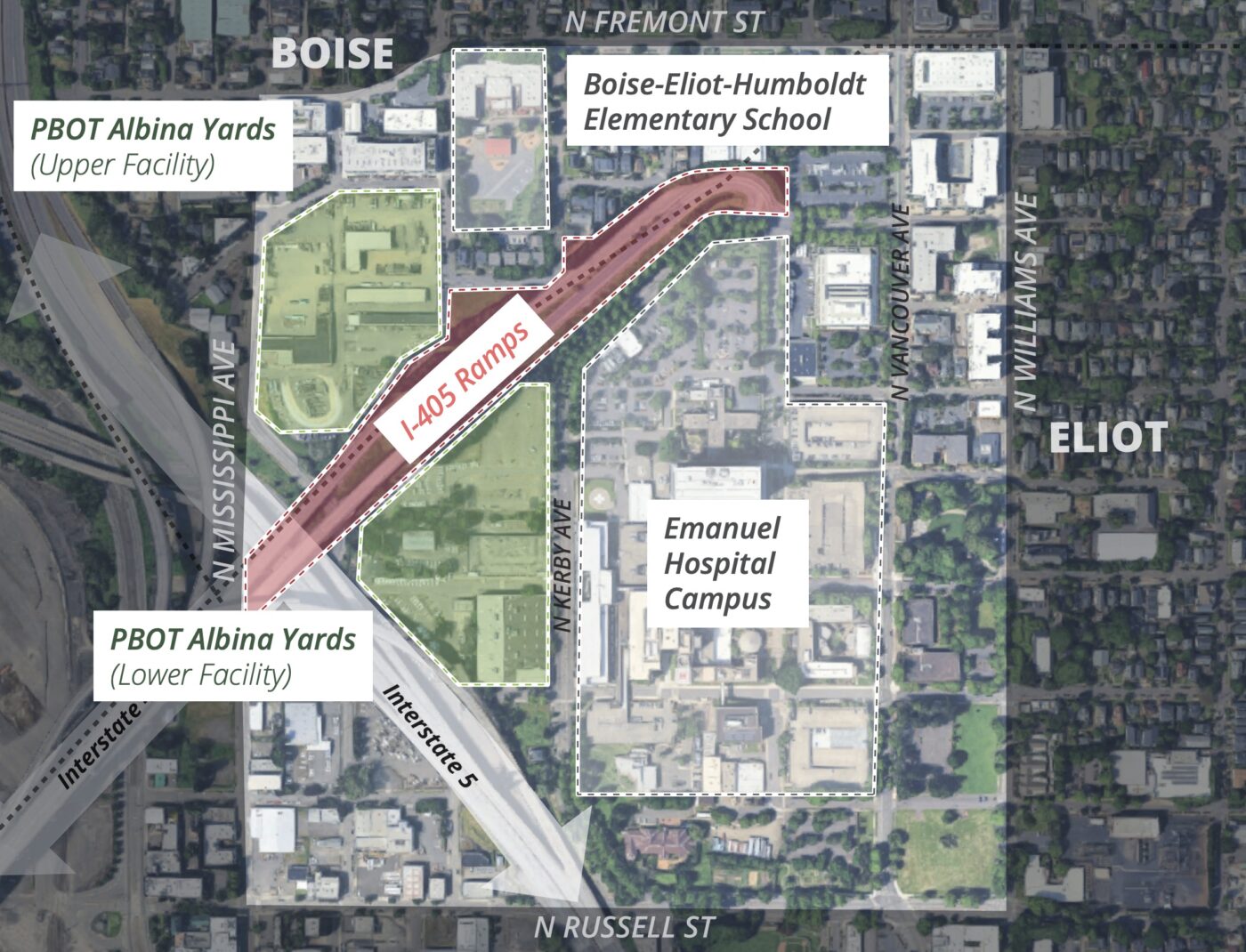
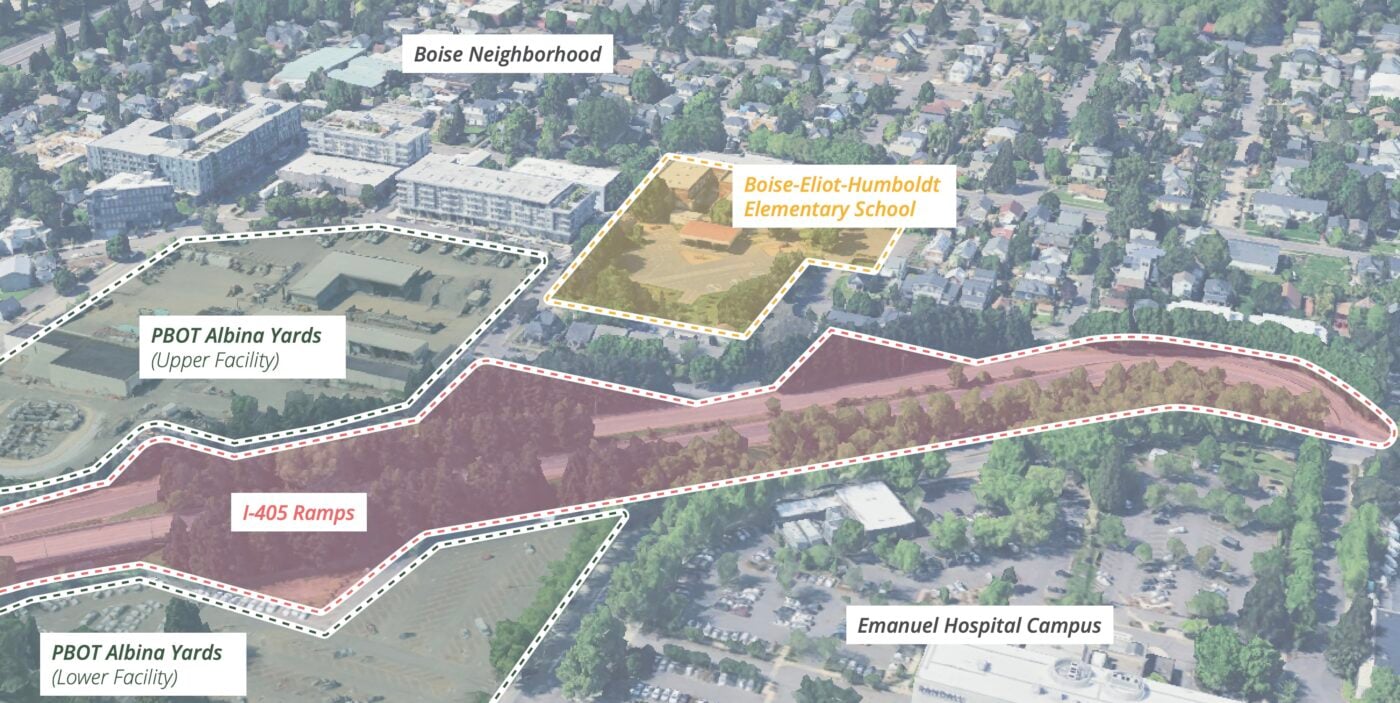
In a joint statement released today from Oregon’s congressional delegation, the Kerby project was one of three planning grants awarded funding through the Biden Infrastructure Law. The announcement also included $2 million each for the Reconnecting 82nd Ave Community Planning Study and the Tualatin-Valley Highway Community Connections Planning Study.
Rudwick’s Kerby Ramp Redevelopment Project will look to re-establish parts of the Eliot neighborhood demolished by the freeway offramp. It will also investigate redevelopment of the City of Portland’s Albina Maintenance Yard, a large equipment storage facility that sits on land carved out by ODOT during construction of the freeway.
“Receipt of this planning grant would allow the City of Portland to pursue creating acres of new land to be used for parks, affordable housing, and new connections between the two neighborhoods,” reads a project description.
In addition to the $1 million from USDOT, PBOT will contribute a $250,000 local match.
See the project website on the Eliot Neighborhood website for more information.


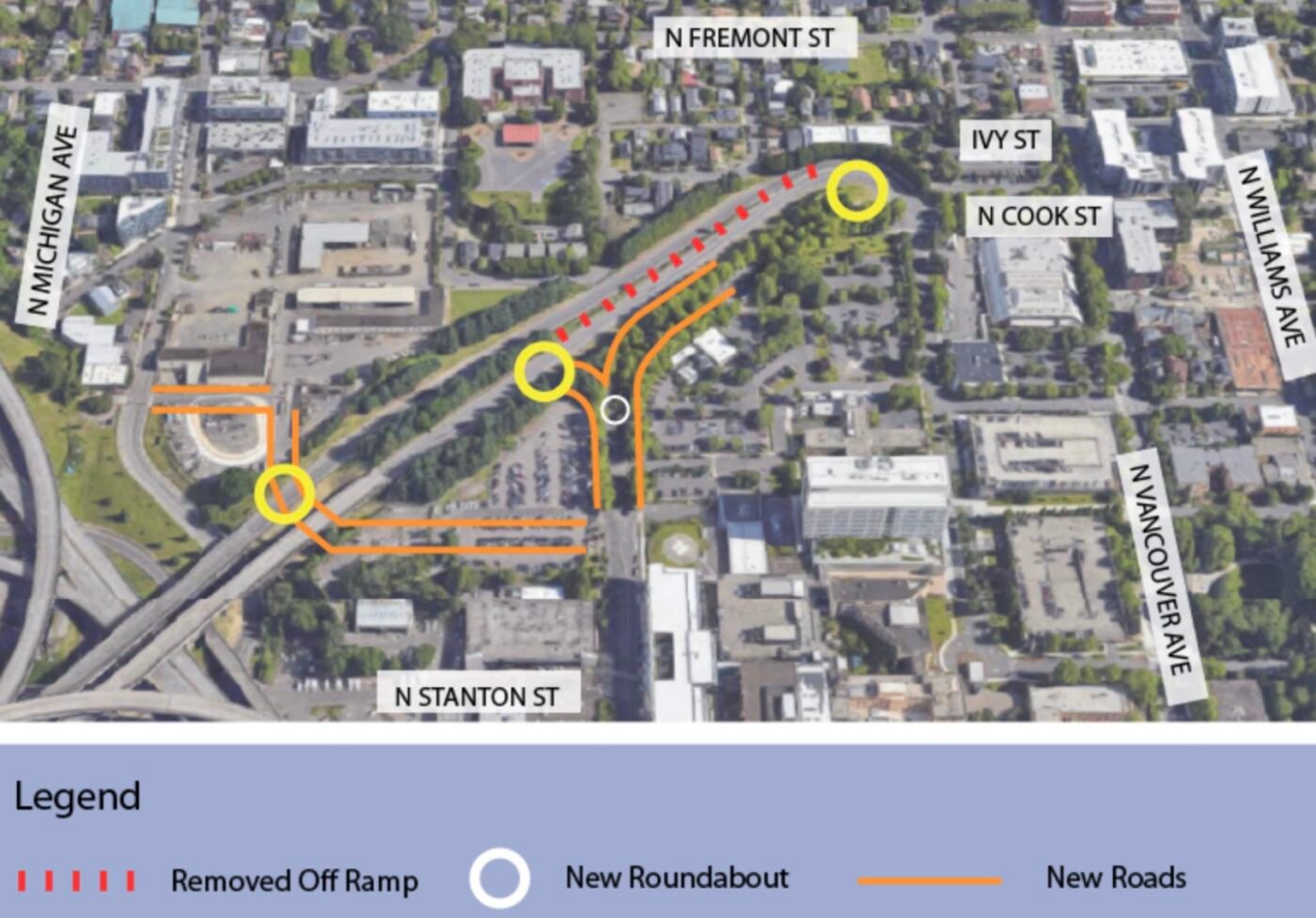


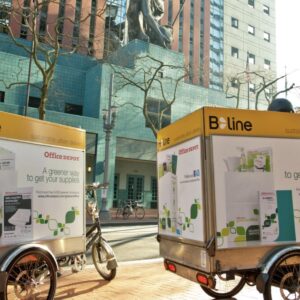
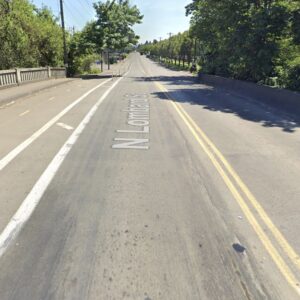
Thanks for reading.
BikePortland has served this community with independent community journalism since 2005. We rely on subscriptions from readers like you to survive. Your financial support is vital in keeping this valuable resource alive and well.
Please subscribe today to strengthen and expand our work.
A profound waste of money. We’re not going to wind the clock back 50 years.
This also fixes a dysfunctional intersection and improves access to the Emanuel Hospital ER, among other things.
You see it as turning back 50 years, I see it looking ahead at least that far. Time is a flat circle, what’s old is new, etc.
This could just as easily be solved with a pet-access tunnel under the existing roadway. But that wouldn’t “protect the community” or whatever.
The current configuration was designed with another freeway connection in mind, I feel like there’s no real difference between terminating the ramps where they are now, or at the actual intersection with N Kerby. Shortening the ramps gives an opportunity for a more connected grid with basically no downside for car traffic. Even emergency vehicles heading to the hospital get a shorter route by exiting directly onto Kerby (with some kind of expanded/changed entrance on the west side of the hospital)
blum’s correct. Little context. The freeway off ramps currently proposed for removal at Kerby were to become the “Rose City Freeway” (AKA “Prescott Freeway”). This would have removed a large portion of NE Portland residents and housing from the current end of the ramps at N Vancouver to Prescott, along Prescott to around 50th and along Killingsworth to I-205.
When MoTRG guy says “wind back the clock 50 years,” what he doesn’t realize is that the original Eisenhower Freeway plan was exclusively imagined as inter-city, not intra city. The idea of induced demand was observed beginning around the ’30s during the time when Robert Moses and other visionaries began to propose intra city parkways in NY. Despite the persistent problem every time a new parkway was built (it’s instantly congested), the plans typically went ahead…
Unless they were in predominately white neighborhoods (e.g., SOHO, Beverly Hills etc), in which case, generally, you see the green on the map below. The intra city parkway systems generally are an indicator of former black (red-lined) neighborhoods. If Portland had not revolted (against the Mt. Hood Freeway, for example) and instead decided to build the planned freeways, it safe to assume Portland would have looked very similar to the vast majority of the other cities in the US. Much of inner SE and NE would have lowered in property values, become blighted, and the white flight and urban degradation that occurred in nearly all other cities in the US would have gutted much of the city (not just the predominantly black parts).
Which would give you greater value, spending your transportation dollars on this, or using that same money to put in traffic calming on state and city streets elsewhere?
2 million dollars could be used as the seed funding to build HUD-regulated non-profit housing development for many dozens of low-income people.
2 million dollars would fund a half dozen diverters or ~1-2 miles of enhanced bike lane.
Urbanists tend to prioritize their twee Jacobsian aesthetics over the boring and pedestrian infrastructure that directly addresses the low-income housing crisis or the climate crisis.
Sometimes “value” isn’t just about traffic and efficiency. It can also be about reconnecting neighborhoods in acknowledgement of the destruction from the highway building processes. I live in the neighborhood and highly value this project. The folks in my Boise neighborhood association had their full support behind this project and signed a letter for that support when submitting for this funding.
I think this is a fairly high value project all things considered. Even though this part of N Portland has a gentrified reputation, there’s still a lot of Black residents. Obviously the issues relating to gentrification are still pressing and present, and people are continuing to be priced out across the board, but it’s not like this is some corner of the city reserved for the well-to-do.
It’s also symbolic. While all of the urban renewal in the area was deeply problematic, the construction of the Kerry ramps (and the botched hospital expansion) stand out as examples where the projects were needlessly destructive. The chance to purposely undo a needlessly destructive project has value to the City outside of its literal value as a project. How much the every day Portlander cares about this is worth considering, but I think it’s a good thing to do.
Is it the highest value project in the state? No. But it’s worth doing in my opinion
Well said blum. It’s really important to note that the Kerby ramps were built around the time of the Fremont bridge, shortly after the time when the majority of the Albina neighborhood was removed for I-5 under the pretense that it was “blighted.” The Rose city Freeway would have demolished another 4800 homes on top of the already insane amount of houses demolished for I-5.
In 1971 neighborhood groups staged a protest on the Kerby ramps, arguing that the ramps would bring traffic, noise and pollution to Albina. These ramps were unused for almost a decade as a result of neighborhood protests and weren’t opened till 1979.
The average house price in the Boise neighborhood according to Zillow is $530,000, the average price in all of Portland is $527,000.
It is an entirely average neighborhood, nothing symbolic at all in 2025.
The population is barely more ethnic in 2025 as the rest of the city.
It’s a decent project that would improve the area. It has or should have Nothing to do with the neighborhood history.
Cities evolve and change.
Boise is 3x as Black as the rest of Portland, and includes Dawson Park which is one of the most visibly Black public spaces in the city. The history of the neighborhood informs that, and that history definitely matters to the people who live and have lived in the neighborhood.
How would you suggest building a project anywhere that has “nothing to do with neighborhood history”? That doesn’t even make sense. There’s history everywhere, and that history informs what exists now.
Of course cities evolve and change. That doesn’t mean context and history are irrelevant in how/why that change happens
I would argue the city would be more interesting and vibrant if we did a better job preserving and building upon our history. A lot of what gets built these days takes no account of context, and our built environment suffers as a result.
1000%.There’s a reason people flock to cities like Paris or Amsterdam — because the cities recognise the history and worked to preserve what makes the city great. Both in architecture and the built environment. This project is a great example of recognising our shared history in the city and building on it to make it better.
This project has little to do with the history of the area as it should. You seem obsessed with it.
Why should infrastructure improvements have anything to do with the history or racial makeup of the neighborhood?
The Boise neighborhood wanted a better off ramp.
They should get one for a number of reasons none of which are racial.
Nothing symbolic about it except in your mind.
Your post suggested this be done for historical or racial reasons instead of common sense.
No wonder Trump won.
Sorry, what are you talking about? The project necessarily has to do with the history of the area because there are things that exist in the area. Those things all exist because of events that have happened.
Right, so the existence of Albina Vision Trust (a primary driver in securing federal grants and fundraising in the area) does nothing to leverage the historical symbolism of the broader Albina area?
It should be done. The justification is intertwined with the history of the area. The ramp is larger than it needs to be because it was planned to connect with a freeway running on Fremont, and the freeway ramp was able to be built in large part because Albina was overwhelmingly Black and lacked political power at the time. Of course, that historical context is not the only reason to do this project. It also makes sense because the only downside is opportunity cost of funds (maybe you’d call that common sense).
What on earth do you mean by this?
Bingo. For all the “there’s no money for sidewalk projects because we only spend money on freeways,” this sure seems like a lot of buck for very little bang.
Not a waste of money for a family that gets to have a house there, or employees who get to earn a living at a business there, or kids who get to play in a park there.
Do you even bother to look at or read the article before you comment?
This is a reconfiguration, possibly an improvement but it’s adding no housing or parks or anything else.
The headline is misleading, very little of the current ramp is being removed.
Perhaps you should read not just the article, but the project page… The reason for reconfiguration is so that the Boise-Elliot community is able to reallocate the land use for things like housing.
Let me quote:
“This project would plan for a new mixed-use neighborhood located along TriMet’s Frequent Transit Network where transit vehicles arrive every 15 minutes or more often all day”
So a tiny apartment building on the 100 yards of road they are taking out is not exactly a NEW neighborhood.
This is false advertising if you know the area.
I live in the area, and I helped to push this project with my neighborhood association. If you actually read the project in the link, there’s space gained not just on the road, but also reallocation of underutilized land use with the facility yards and parking lots.
I do think it is a good project but the reallocation of facility yards could be done regardless of the off ramp change.
The amount of roadway actually goes up with this project.
It will be nice but hardly transformative.
I disagree but let’s come back in 15 years to this post and see how transformative it truly was!
A simple measuring tool on Google Maps shows that the potential ramp removal would be roughly 900 feet, or 300 yards, not the 100 yards that you say in your post. 900 feet is more than four typical Portland city blocks. And the width of the ramp is such that you would get at least four full city blocks out of this, potentially even more.
Second paragraph: I’m not sure that it’s really a “removal” rather than a “reconfiguration” like your headline says. Removal implies people NB on the I-405 Fremont Bridge would no longer be able to get off the bridge in the Kerby area. I don’t think that’s true.
Yes sorry. I had swapped “removal” for reconfiguration in headline but forget to do it in the body text of the story. Fixed now.
Nice to see some changes, but sort of bummed that there’s not much grid re-connection going on. North Kerby in particular – it seems like they could just extend the street a little bit into the removed off-ramp area without much issue?
The graphic shown is not a very good one. The study itself is written to be very expansive, looking at all kinds of grid reconnection opportunities, street reconfigurations, and creation of new land for redevelopment.
Ah good! I was hoping to dive into the study later today, glad to eat my premature words 🙂
Question for JM to ask city staff at PBOT:
Why is the removal (reconfiguration) of this ramp so necessary, yet all the others for the Rose Quarter and Columbia Bridge are apparently so needed? What make this one so “surplus to need” that it needs reconfiguring? And why now?
Pretty sure if I asked that their response would be: “Well we don’t know, but it’s intriguing enough to warrant a study to find out more. And that’s what this grant will do.”
Why is there not a similar study, for example, to reconfigure Interstate Avenue back to the way it was before all the onramps were added, between Lombard and Vancouver WA (i.e. the present I-5)? Put in roundabouts and signalized intersections, get traffic to slow down to 30 mph or less, reclaim land for development, wetlands, and parks, perhaps not build a new $7 billion bridge?
This was a stub of a much longer freeway that was later cancelled, so it’s a very different situation than all the other ones.
Yep, Alan, here’s a decent blog post and vid on the abandoned freeways of Portland starting in 1943 when Multnomah Co. invited Robert Moses to write his 87 pg report recommending, “14 freeways, 14 expressways, and five new bridges.” There are a lot of remnants of freeways that were never built. There is a great quote from Moses at the start:
Any alternative to a cityscape that did not include vast freeway landscapes was considered unrealistic and quaint by city planners at the time. Cars equaled progress. If you’ve been to battery park, it’s crowded and touristy, but there isn’t a massive freeway overshadowing it (but there is one across the Bronx, which is currently planned for expansion SMH). It’s bizarre that we still live in a time where that ideology dominates our cityscape and public funding on transportation.
It would be better if it were a full removal. Local travel by interstate is a huge obstacle to better zoning, modal shift and causes the congestion that is used to justify the never-ending expansion of asphalt death zones in the center of the city.
Agree. The area at N Cook street where the Vancouver bikeway intersects with traffic entering and exiting the freeway is awful. Removing that conflict point would destress the whole area and make biking in that neighborhood more appealing.
The impact of closing the ramps would almost certainly be drivers clogging up Vancouver and Williams to get to the area, making unsafe passes in the bike lanes and resulting in someone getting seriously hurt or killed. In contrast, this reconfiguration is a win for everybody.
Not at all. This is a ramp off of 405 N/E. Where are they coming from? Any diversion to the area via surface streets, would be offset by the number of people not driving into the area to get onto the 405 S/W.
We are either spiraling toward complete domination of the asphalt hell-scape that we live in, Or, we are spiraling away from unregulated personal auto use.
People have to stop using cars for every trip. Using the interstate for trips under 5 miles, which is what it is primarily used for, is a disaster generator and budget vacuum for Portland.
“People have to stop using cars for every trip.”
How do we stop them?
As the opportunity arises, rebuild the transportation system to favor rational transportation vehicles. As an example, take out this redundant ramp.
Sure, remove the ramp. I don’t oppose that at all. Hopefully doing so won’t cause more people to drive on surface streets where they can cause conflicts with pedestrians and bicyclists, degrading “rational” transportation.
There’s a few assumptions here. First, the idea that traffic numbers are static. Cars are not people. As we see with past changes (e.g., congestion pricing, freeway removal) people make decisions and adjust their route and mode of travel based on a lot of factors. This ramp was closed for the greater part of the ’70s when the neighborhood rallied against it. Where did drivers go then? Where were all the drivers on I-5 prior to the removal of Albina? How did they make their decisions to travel when there were no urban freeways? How can many cities outside the US have fewer or no urban freeways and still have very functional transportation systems?
Second, more cars on a street does not mean drivers will drive less safe. I think this is a very odd argument often used against road diets, and street designs in general. That is, somehow the street alignment change suddenly makes drivers go into a frenzy and the burden is upon the public to keep them from freaking out. Streets change all the time. People who drive cars should be required to be flexible and understand that driving is a privilege, not an inalienable right.
It was inactive for nearly a decade from around 1971-79 because of neighborhood protests. I’d be surprised if Emmanuel didn’t have some stake in getting it opened. But it shows how easily people change their habits, and how a closure likely wouldn’t be a huge deal.
Allan Rudwick has spent countless hours working on this land reclamation project over the years. This initial grant award is hard-won, but such sweet proof that citizen activists can effect change. Thank you, Allan, for your tenacity and toil for the people of Portland.
Yes, great job Allan, and thanks to the Boise-Eliot Neighborhood Association for supporting you!
This grant funds the building of nothing. It funds studies. It might as well fund the appointment of a committee to begin the commencement of public involvement meetings to debate the preparation for alternatives analysis. Physical construction will be lost in bureaucracy.
Umm do you think we should initiate construction projects without planning then? I agree there’s a risk of planning things to death, but come on. It’s actually smart and good to investigate and dive deeper into issues before deciding to make major changes to stuff.
Umm…of course I do!
Planning should be rolled up into a tiny crinkly ball and set on fire when it comes to affordable (medium to high-density) rental housing which is the only type of housing that the state should be encouraging and/or subsidizing during this chronic and festering low-income housing crisis.
The concept of the proposal has merit, but Portland is a black hole of inefficiency. Planning can be done without the layer upon layer of navel gazing stakeholders.
This exactly. Let’s waste tons of money trying to unravel a Gordian knot from 2 generations ago.
You could argue that funding studies might be superfluous for generic reasons or the use of funds for planning might be inefficient in Portland in general.
But acquiring funds via specific grants (e.g., RCP) requires a lot of resources, grant writing and a lot of research and prep. So do a lot of other funding sources. There a very good reason for that: efficient use of funds based on the available evidence. In essence, arguing that a governmental body or non profit should simply give money without requiring the grant writer (Allan Rudwick) offer some reasonable evidence why they are a worthwhile recipient, is exactly what a “black hole of inefficiency” would be.
Sounds like someone supports hundreds of millions of dollars being sunk into studies for a new interstate bridge.
Yeah, we should just randomly build things without doing any studies first! That will work out great!
Yes, we should be building affordable rental housing according to city codes as quickly as possible and without the barriers and delays imposed by “studies”. The city owns a shit-ton of land that could be immediately turned over for developed (e.g. via HUD/LIHTC/VA and other mechanisms).
Besides endless studies, our great city is considering cutting millions in funding for homeless services and graffiti removal so as increase the budgets for all our new council persons offices.
This new government we have was such a good idea….
I unambiguously support graffiti artists and houseless people far more than I support priggish homeowners who want to reconnect streets so they can take nice walks in their gentrified neighborhood* (that has been stripped of affordable housing for low-income people).
Nevertheless, it’s no surprise that classist and elitist city bureaucrats lied through their teeth about the costs of a transition that will leave them with virtually no oversight from an elected official.
* this is literally the argument some market-urbanists are making for this planning exercise on social media
The reason those City codes that you mention allow building much of that housing is because there were STUDIES done years ago that led to changes in the zoning code to allow them.
If the City had listened to anti-planning people back then, many of the areas that now allow that type of housing to be built would still only allow things like low-density housing or low commercial buildings with large parking lots to accommodate all the code-required parking.
Is there a low-income housing **emergency** or not, qqq?
qqq excellent point. Portland is still very “North American” in its zoning laws which only somewhat recently improved when the code to include duplexes, grama houses etc. via the Housing Adjustment Compliance Project that went into effect Jan 1. But R5 still encompasses +70% of Portland’s area. The housing “emergency” is partially due to limiting land use for the greater part of the last century to single family housing (and the disinvestment of public housing). Even though the UGB encompasses 250,000 acres, it is still an outlier for US cities (only 12 states require it).
Props to Alan Rudwick, the Eliot Neighborhood Association, and all of their allies for setting this up and pulling it through.
I first met Alan in PBOT’s now-defunct “Portland Traffic and Transportation Class” in 2009. And have worked on parallel projects with him ever since in Boise Neighborhood. (The neighborhood on the north side of the Kerby Ramps).
Note to everyone — if you want to see change in our transportation infrastructure, you can make it happen. You could be a tireless flag bearer like Alan and the Eliot NA. But you can also be a supporter, an encourager, an organizer, etc. to help good ideas see the light of day. Attend your NA meetings, volunteer with other groups. Etc. lots of PT&T Class alums from ‘08 and ‘09 (when I attended) have gone on to lead or fund/fuel/support a lot of significant changes in the bicycling infrastructure that otherwise probably wouldn’t have happened.
A couple other notes.
1) rather than “removal” or “reconfiguration”, the accurate term here is “to truncate”. (“Truncation?”)
The “Kerby Ramp” overshoots Kerby and terminates at Gantenbein Ave. Car traffic doesn’t benefit from this overshoot, and it sits, unnecessarily, on a lot of land.
The plan as by the Eliot NA (top photo) truncates the exit ramp back to Kerby Ave, and the entrance ramp back to Albina Ave.
This is 1/8 mile for the exit, 1/4 mile for the entrance. Thus freeing up a lot
2) As mentioned, this exit and entrance “ramps” are the beginnings of a 4 lane freeway, the “Prescott Freeway” which was never built.
Planned original orientation is here. (1966)
https://www.flickr.com/photos/11599639@N03/26185201650/
3) The big challenge moving forward will be to convince ODOT that the new ramp terminus intersections should be *small* and *slow.*
Any freeway exit intersection built in the last 40 years has been really big. Several left turn lanes. Several right turn lanes. Wide radius corners on the intersections.
It’s not necessary here. Primarily because there is no capacity for increased car traffic on any of the nearby desirable surface streets (Mississippi, Williams, Vancouver, Fremont).
Secondarily because if a large intersection is built here it will take up most of the freed-up land.
But “small freeway ramp intersections” don’t exist in any ODOT guidebook. So it will likely be another long effort to try to convince them to do it.
Ted Buehler
Ted, I get that the neighborhood has been campaigning for this for a long time. We both know that to get certain kinds of funding, a project must be somewhere in an approved plan, and this is a first step in that direction. We also know that certain other projects got approved, funded, and built without being in any plan whatsoever – certain plans got “amended” after the fact – usually due to political expediency and/or sudden federal stimulus funding. When I was an advocate in East Portland I frequently saw projects in both categories.
My assumption when I see a study like this (plus the other two mentioned) is that PBOT (or in some cases ODOT) is assuming a significant project is about to get axed by the feds (Rose Quarter comes to mind as does the I-5 Columbia Bridge) and that certain state funding will suddenly become available for all kinds of projects citywide, so the city wants to make as many projects “shovel-ready” as possible.
A brief note on the PBOT traffic and transportation class (from a fellow graduate!). It’s in a new form and has been taken over by Metro, and is run out of PCC instead of PSU (this is based on me recalling a post from a Metro councilor on Instagram)
Wow! I’m happy to be wrong!
Thanks to Metro for keeping this great resource in operation.
Looks like it happened in 2024 and will continue!
https://www.portland.gov/transportation/walking-biking-transit-safety/traffic-transport-class
This is the Frog Ferry of Boise.
Yes, let’s make it harder to commute to jobs in Washington County and less appealing to live in North Portland. Genius.
TD
I’m curious — what is your basis for your ironic praise here?
I live six blocks from the Kerby Ramp terminus. I’ve had housemates to commute to Washington county. Nothing in this proposal is likely to make it any more difficult to drive from inner NE to Washington County via the Kerby ramps to I-405 southbound.
Also I’m not sure why you think this would make it less appealing to live in N Portland — a chunk of surplus land would be reclaimed from an abandoned 1970s freeway project and turned into mixed use housing/residential.
Ted Buehler
Yes, let’s do it!
One thing that makes me particularly happy about this is that Eliot has spent decades being the dumping ground for everything that wealthier, more politically connected neighborhoods didn’t want in their neighborhoods.
Many people who lived there during those decades are dead or have moved, but not all, and there’s value in remedying the scars that remain.
There’ve been many people in Eliot over the decades who’ve fought for better treatment from the City and State without getting very far, so it’s nice to see Eliot having some success now.
This is a good and necessary change; pretty much a win-win for everyone. The current configuration is designed with the canceled Prescott Freeway in mind rather than serving as local access to I-405. Removing the ramps is probably a non-started due to access necessary from the Fremont Bridge to the hospital as well as the diversion to Vancouver/Williams that would result. But the ramps can easily be shortened without impacting functionality, and the extra space used for much-needed housing and neighborhood reconnectivity.
Sounds like you’re just making stuff up- like hospital access and diversion. The study should include whether these thing are actually real considerations and the impact of complete removal. When Los Angeles is burning and we are passing 1.5, you should back up your vibes with numbers if you’re going to shill for fossil fuel gluttony.
I was going to write a detailed response until I saw this part. Name-calling and throwing insults around will never get you anywhere in advocacy, and just serves to push people away from your ideas. Care to say what numbers you’d be interested in seeing? I’m not a traffic modeler.
This, x10.
Since you don’t seem to know the difference between “name-calling” and criticizing an idea, I am glad that you are keeping your detailed response to yourself. Thank you. It would probably just be a list of unfounded conjecture that is based on the premise that our problematic, planet destroying, transportation system cannot change.
As far as the numbers I would really like to see… if you are going to take the time to think about this, you should burn that brain glucose on considering why you reflexively defend motonormativity. New ideas are harder, but ultimately more rewarding than pseudo-authoratative fatalism.
“you don’t seem to know the difference between “name-calling” and criticizing an idea”
Which idea, exactly, were you critiquing when you called this person a “shill for fossil fuel gluttony”?
verbs vs nouns, bruh.
Ah yes, the critical difference between “you shill for fossil fuel gluttony” and “you are a shill for fossil fuel gluttony”.
So much nuance gets lost on the internet.
Yes, the difference is substantial.
The action is something you can do as a one off, when you’re making the argument that maintaining maximum car use is the most important consideration.
Like when you tell a child “you are good, but the thing you just did was bad, because….”
Stating that someone is a shill implies that their default is to shill. It is much more reductive and moves the discussion away from the exchange of ideas and, instead, to an appraisal of the value of each individual, which is a waste of time.
It can be hard to hear someone point out that your idea is bad because it ultimately leads to mass migration, starvation and human suffering. It can feel like someone is calling you a name. But, this isn’t the case. If your idea is solid, defend it with more than just vibes.
You do realize, I hope, that accusing someone of shilling and making things up (essentially of arguing in bad faith and lying), is not generally regarded as the sort of firm but loving guidance a parent might offer an errant child, nor as a substitute for a well reasoned response to a minor point you take issue with.
You made no effort that I can see to show why the original poster’s ideas were “bad” or why you take issue with them. And tying the question of whether a highway offramp continues to serve any purpose to “mass migration, starvation and human suffering” is such gross hyperbole that I’m starting to think you’re “taking the piss” as they say in England.
Close the ramp, leave it alone, or double its size — none of that is going to exacerbate mass migration or lead to starvation.
Good point. “Shilling” requires more self-awareness than is apparent in these comments.
On the other hand, the “this one ramp” is the missed point. Approaching every climate negative choice as “will this one thing change everything? Nope, I guess not. Cars it is. Let’s just choose polluting, destructive car dominance in every situation, because if we dissect out this one choice it is inconsequential. And, connecting something so small to the drastic effects of climate change is the worst of all internet comment faux pas’es… Hyperbole!”
Not sure if you read an earlier comment on this. I’ll link. Although you are correct that this is a left over from a cancelled freeway (see above), the current conditions were unused for almost a decade during the ’70s, because the residents were opposed to increase traffic, pollution etc.
You could argue that the neighborhood has changed and now “requires” car access. I would argue that the more popular and dense a place gets, the less car access it should have, particularly freeway access. Most of the downtowns in the US have been sacrificed for parking and freeways, “solving” the congestion problem by making them not worth going to. Think of all the most economically viable places, and you’ll find very few with freeways or fast car traffic next to them.
Remember, the area that was Emanuel hospital, I-5, the Fremont Bridge, The Mem. Coliseum, were all a part of one of the most vibrant neighborhoods that has existed in the city. And people there had no freeway access.
Half of us will be gone before this is meaningfully fixed. It’s a nice idea but one million isn’t going to do much.
This grant program was likely written for the expected “2nd Biden/Harris” administration*. Perhaps it will be on the shelf AND ready for the post Trump2 administration cycle.
[*I experienced similar scenario that was ramping up for the impending Gore administration…when I was awarded to do a pilot low emissions carsharing / shared fleet bike vending project by the US EPA. Successful pilot that was BUT became ~10 years ahead of the retail trend once Bush43 and 9/11 recalibrated the national discussion.]
Congrats Allan. Hey, may I put a planning ‘bug in your ear’? Think about putting a ‘design placeholder’ in this planning project for retrofitting a SB protected Bike Highway lane to the NW Industrial area / Pearl Slab Town on the shoulder I-405. [Perhaps bi-directional with an e-bike.] Just crazy dreaming.
Whoa crazy talk. I like it. That’s like putting a bike lane on the Verrazzano. Cars nneeeeedd all those 13 lanes. Bridge pedal every day. Dunno if it was the Marquam or the Fremont, but I remember being able to put my arm through the spaces between the sections.